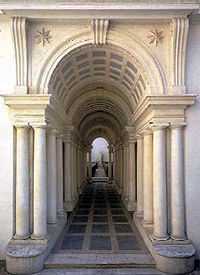Palazzo Spada


The Palazzo Spada is a palace in the historic centre of Rome, Italy. It is located in the rione Regola, at Piazza Capo di Ferro, 13, very close to the Palazzo Farnese. It has a garden facing towards the River Tiber.
The palace accommodates a large art collection, the Galleria Spada. The collection was originally assembled by Cardinal Bernardino Spada in the 17th century, by his brother Virgilio Spada and added to by his grandnephew Cardinal Fabrizio Spada,
History
It was originally built in 1540 for Cardinal Girolamo Capodiferro. Bartolomeo Baronino, of Casale Monferrato, was the architect, while Giulio Mazzoni and a team provided lavish stuccowork inside and out.
The palazzo was purchased by Cardinal Spada in 1632. He commissioned the Baroque architect Francesco Borromini to modify it for him, and it was Borromini who created the masterpiece of forced perspective optical illusion in the arcaded courtyard, in which diminishing rows of columns and a rising floor create the visual illusion of a gallery 37 meters long (it is 8 meters) with a lifesize sculpture at the end of the vista, in daylight beyond: the sculpture is 60 cm high. Borromini was aided in his perspective trick by a mathematician.
The Mannerist stucco sculptural decor of the palazzo's front and its courtyard façades feature sculptures crowded into niches and fruit and flower swags, grotesches and vignettes of symbolic devices (impresi) in bas-relief among the small framed windows of a mezzanine, the richest cinquecento façades in Rome.

The colossal sculpture of Pompey the Great, erroneously believed to be the very one at whose feet Julius Caesar fell, was discovered under the party wall of two Roman houses in 1552: it was to be decapitated to satisfy the claims of both parties, which appalled Cardinal Capodiferro so, that he interceded on the sculpture's behalf with Pope Julius III, who purchased it and then gave it to the Cardinal.
The palazzo hosts the Galleria Spada, the Cardinal Spada's collection, which includes four galleries of 16th and 17th-century paintings by Andrea del Sarto, Guido Reni, Titian, Jan Brueghel the Elder, Guercino, Rubens, Dürer, Caravaggio, Domenichino, the Carracci, Salvator Rosa, Parmigianino, Francesco Solimena, Michelangelo Cerquozzi, Pietro Testa, Giambattista Gaulli, and Orazio and Artemisia Gentileschi, has the additional interest of being hung in the 17th-century manner, frame-to-frame, with smaller pictures "skied" above larger ones.
Palazzo Spada was purchased by the Italian State in 1927 and today houses the Italian Council of State, which meets in its richly frescoed and stuccoed rooms.
External links
- Official website
- Aerial photo - The Farnese is the large square palace at the left, while one block along the same street to the south-west is the smaller Palazzo Spada with its gardens facing the Tiber.
- Dido's Death, Guercino, commissioned from Guercino by Cardinal Spada, 1631, on behalf of Marie de Medici
- Video of Palazzo Spada
- Empire of the Eye: The Magic of Illusion: Palazzo Spada's Corridor, Part 5 (flash video)
- Orazio and Artemisia Gentileschi, a fully digitized exhibition catalog from The Metropolitan Museum of Art Libraries, which contains material on Palazzo Spada (see index)
| ||||||||||||||||||||||||||||
Coordinates: 41°53′38.5″N 12°28′18.5″E / 41.894028°N 12.471806°E